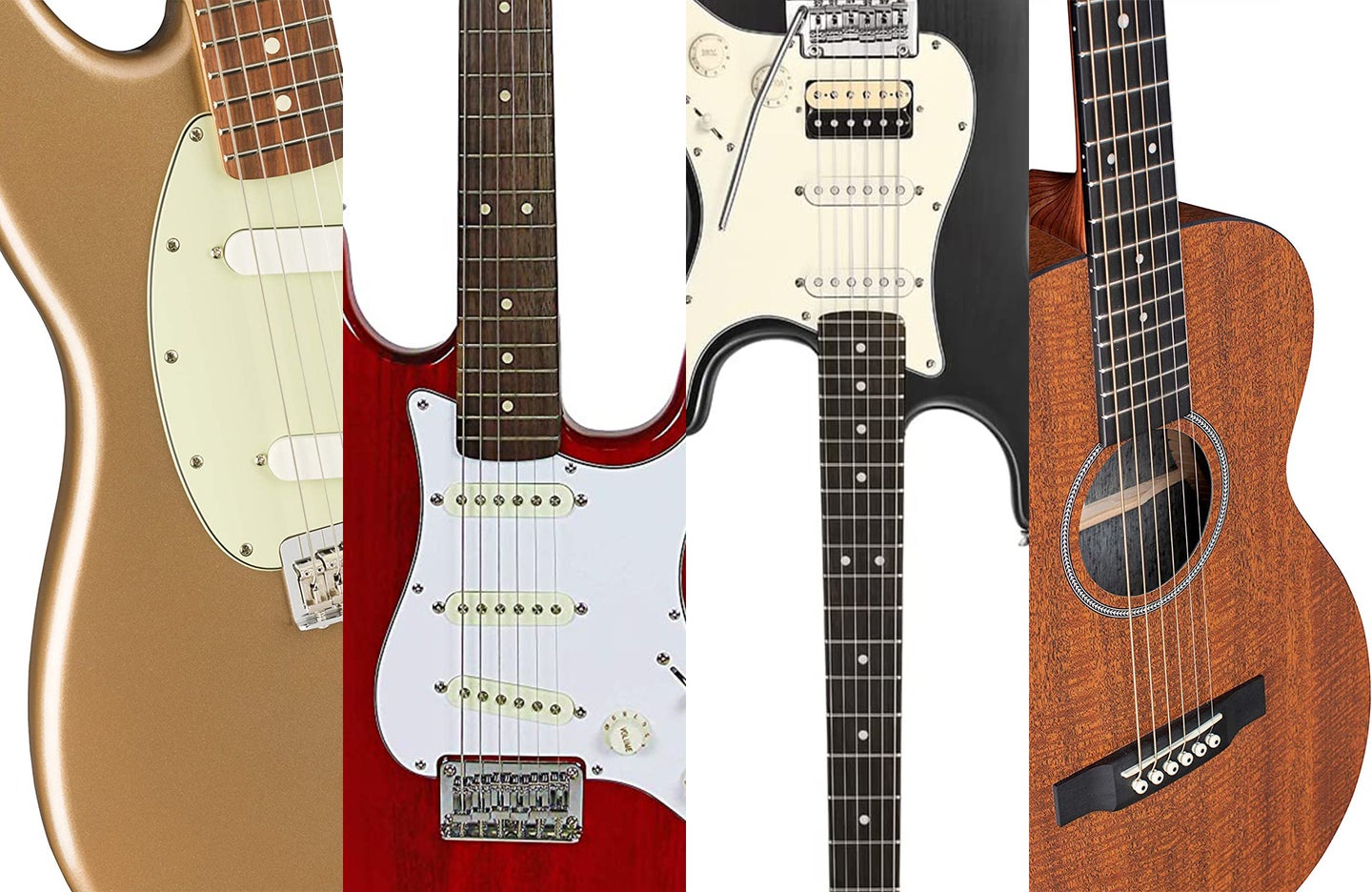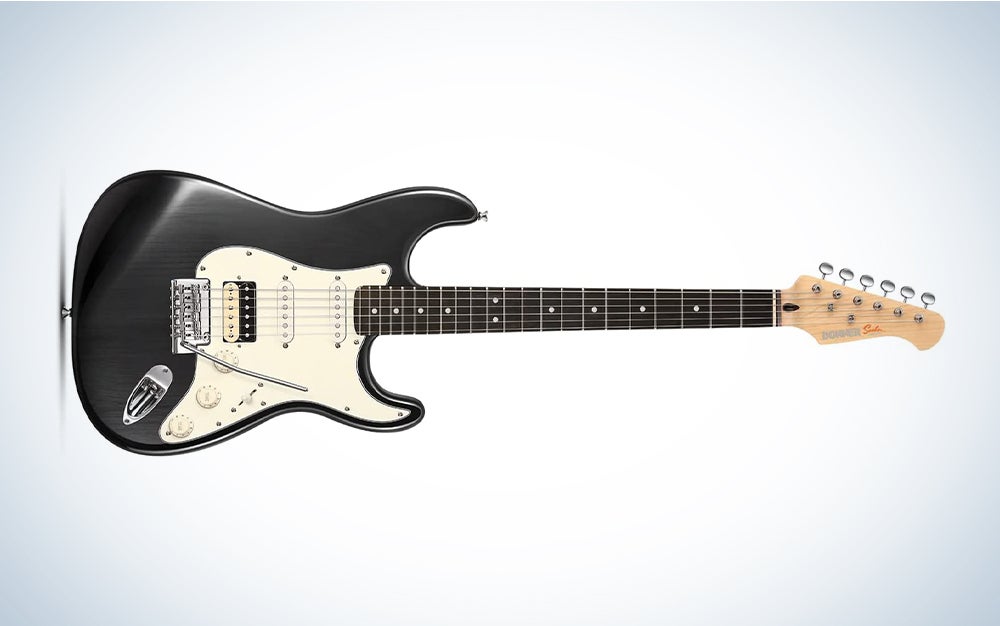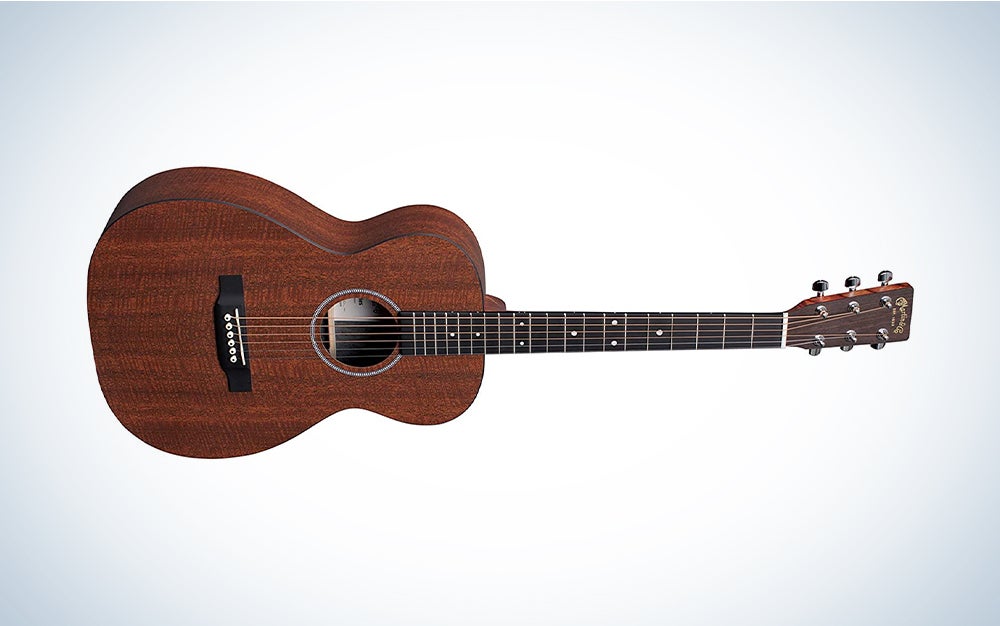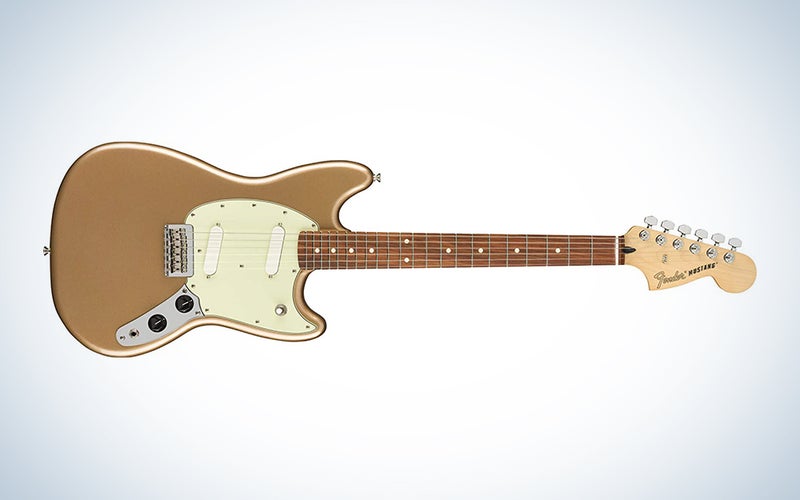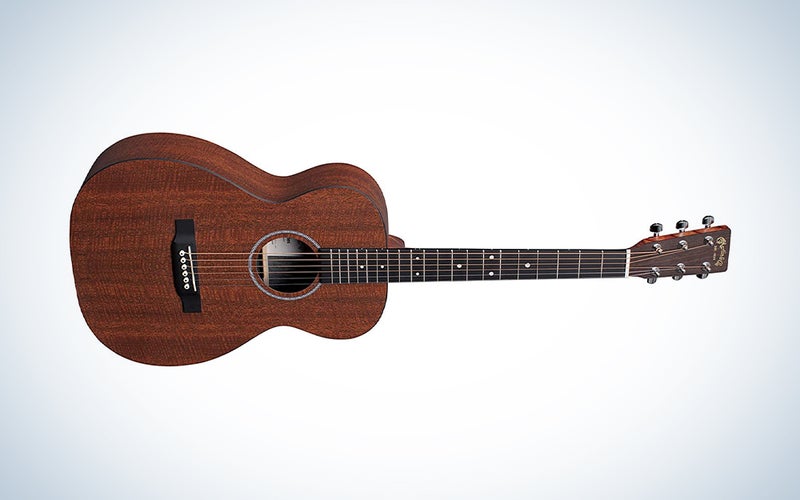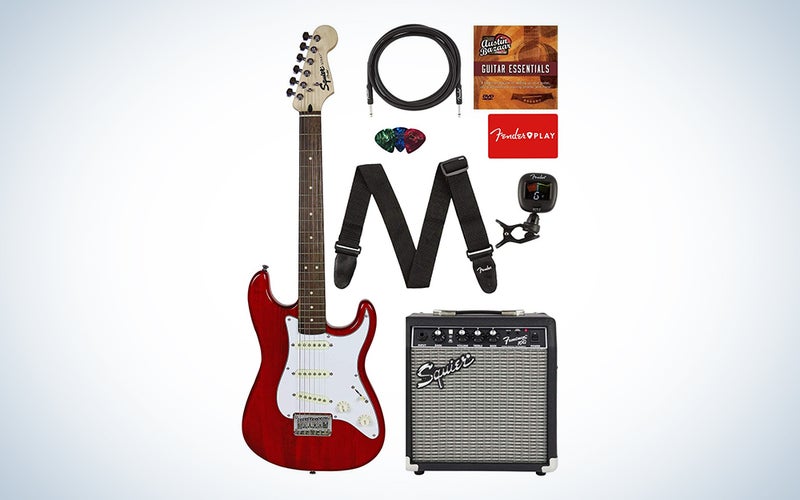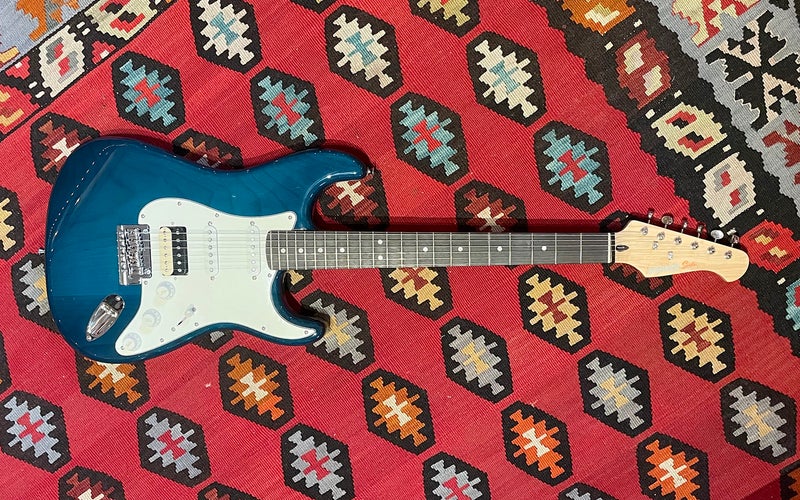We may earn revenue from the products available on this page and participate in affiliate programs. Learn more ›
The enduring popularity, ubiquitous sound, and incredibly fun-to-play design of the electric guitar make it a fantastic entry into the world of music performance and a worthwhile endeavor for musicians of every skill level. While guitar players come in all shapes and sizes, the best guitars for beginners are almost always scaled down for comfort and designed for ease of playability above all else. Whether you’ve never picked up a guitar or you’re a musician looking for a more stripped-down and easier-to-play instrument to add to your collection, this list of the best electric guitars for beginners has something for every player and every style.
- Best overall: Fender Player Mustang
- Best semi-hollow: Epiphone ES-335
- Best acoustic: Martin 0-X1E
- Best bundle: Fender Squier 24-Inch Strat Pack
- Best budget: Donner DST-400
How we chose the best electric guitars for beginners
We compiled this list of the best electric guitars for beginners with a heavy emphasis on design and playability. Many guitars on the list also feature short-scale designs, small bodies, or tapered necks, all of which make an instrument more comfortable and easier for small hands to play. We placed secondary emphasis on brand reputation, choosing brands like Fender, Epiphone, and Martin that have shaped the history of guitar music. While we gave some consideration to price, we included many intermediate-priced instruments, opting for the philosophy that it’s easier, more fun, and more sustainable to learn on a guitar that’s built well.
The best electric guitars for beginners: Reviews & Recommendations
When selecting the best guitar amps, we combined personal musical and production experience, the opinions of trusted peers, insight from published critics, and online user impressions. After looking at everything on the market, these are our top picks for electric guitars for beginners.
Best overall: Fender Player Mustang
Fender
Why it made the cut: An easy-to-play neck for small hands and a classic, versatile solid-body tone make the Mustang an ideal electric guitar to grow with.
Specs
- Body: Solid alder, polyester finish
- Neck: Maple bolt-on, C shape, satin urethane finish
- Fretboard: Pau Ferro, 9.5-inch radius, 22 medium-jumbo frets
- Scale length: 24”
- Electronics: 2 x Mustang Single-coil pickups
- Bridge: 6-saddle string-through-body hardtail Strat
- Accessories: None included
Pros
- Smooth, comfortable-to-play neck and small body
- Simplified electronics offer easy access to a range of tones
- Classic, stylish design
Cons
- Distinctly bright tone might not be for everyone
The Fender Player Mustang is a compact solid-body electric guitar with a distinctly snappy tone and easy-to-play design that make it an exciting and appealing choice for beginning players. Unlike the Fender Stratocaster, which shares many of its tonal characteristics, the Mustang features a short 24-inch scale length and a streamlined electronics configuration giving it a satisfying immediacy and better suited for players with small hands and bodies. The Mustang’s two single-coil pickups and simple tone and volume controls offer a reasonable range of tonal options for rock, jazz, funk, and more. Like most solid-body electric guitars with single-coil pickups, the Fender Mustang has a bright and jangly quality equally suitable for strumming chords and taking solos. Players who prefer a deeper and more resonant tone may prefer our next pick on this list, the hollow-body Epiphone ES-335.
Best semi-hollow: Epiphone ES-335
Epiphone
Why it made the cut: The Epiphone ES-335 features a semi-hollow design based on the legendary Gibson guitar of the same name, making it a budget-friendly pick for beginners who don’t want to compromise on sound quality.
Specs
- Body: Semi-hollow maple, gloss finish
- Neck: Mahogany set neck, rounded C shape
- Fretboard: Laurel, 12-inch radius, 22 medium-jumbo frets
- Scale length: 24.75”
- Electronics: 2 x Alnico classic PRO humbuckers
- Bridge: Epiphone Tune-O-Matic with stop bar
- Accessories: None included
Pros
- Warm and resonant tone perfect for jazz, blues, and rock
- 12-inch neck radius for easy-to-bend notes
- Gibson-inspired sound and sustain in an affordable package
Cons
- Large body may be uncomfortable for smaller players
- Feeds back at high volumes
Modeled after the Gibson ES-335 favored by B.B. King and Chuck Berry, the Epiphone ES-335 is a semi-hollow electric guitar that delivers all the same growling sustain and resonant tone of its namesake at an affordable price point. Outfitted with two humbucking pickups and constructed with a solid maple tone block in its interior, the ES-335 has a woody and organic sound heavier on the low end, making it a particularly appealing option for beginning jazz and blues guitarists. When paired with effects and overdrive, the Epiphone ES-335 can also hold its own in a range of rock and pop styles, although its semi-hollow design makes it prone to feedback when played through very loud amps. The guitar’s 12-inch-radius neck is a bit flatter than the 9.5-inch designs found on many Fender guitars, giving it a slight edge for ease of bending notes. While beginners with shorter arms may find the ES-335’s large body difficult or uncomfortable to hold, the Epiphone ES-339 is a nearly identical design that offers the same sonic characteristics with a smaller, easier-to-hold body.
Best acoustic: Martin 0-X1E
Martin
Why it made the cut: Martin’s 0-X1E electric-acoustic is the ideal travel companion thanks to its durable laminate construction and portable tenor-size body.
Specs
- Body: High-pressure laminate, satin finish, tenor size
- Neck: Birch laminate, performing artist profile
- Fretboard: Richlite, 16-inch radius, 20 frets
- Scale length: 24.9”
- Electronics: Fishman MX under-saddle pickup
- Bridge: Richlite
- Accessories: Gig bag
Pros
- Lightweight and durable with a small, portable body
- Easy-to-play tapered neck
- Resistant to changes in temperature and humidity
Cons
- Laminate top sounds mellower than traditional spruce wood
The Martin 0-X1E is a small-body electric-acoustic guitar that’s easy to play and transport, making it a great choice for beginners and players on the go. Designed to be a more affordable and durable alternative to traditional wooden designs, the 0-X1E is constructed from high-pressure laminate that’s notably lightweight and very resistant to changes in humidity and temperature, allowing the guitar to endure less-than-ideal storage and travel conditions. The Martin 0-X1E features a tenor-sized body and a tapered maple laminate neck, striking a good balance between playability and tone while making the guitar easy to hold for smaller players. While the 0-X1E sounds fantastic, if not a bit mellow while unplugged, the guitar’s Fishman MX under-saddle pickup allows for connection with guitar amplifiers and PA systems, making it easy to use when recording or performing live. For a similar playing experience with a larger body, the Martin D-X1E is also worth a look.
Best bundle: Fender Squier 24-Inch Strat Pack
Fender
Why it made the cut: This starter pack from Squier is built around a compact, easy-to-play Strat-style guitar and has everything you need to get started.
Specs
- Body: Poplar, polyurethane finish
- Neck: Maple bolt-on, C shape, satin finish
- Fretboard: Hardwood, 9.5-inch radius, 20 medium-jumbo frets
- Scale length: 24”
- Electronics: 3 x single-coil Stratocaster pickups
- Bridge: Hardtail 6-saddle Strat bridge
- Accessories: Gig bag, amp, strap, tuner, cable
Pros
- Includes an amplifier, strap, and other essential accessories
- 24-inch scale design is perfect for smaller players
- Packs versatile Strat tone in a small package
Cons
- Beginner-level gear won’t endure into intermediate level
Suppose you’re looking for a quick-start kit for beginners. In that case, the Fender Squier 24-Inch Strat Pack balances price, quality, and flexibility, making it one of the best all-in-one guitar bundles currently available. The kit is built around a 24-inch scale Stratocaster-style guitar with a traditional three single-coil pickup design, delivering classic solid-body tones in a uniquely compact and easy-to-play package that feels similar to the Fender Player Mustang at a more affordable price. The kit also includes a 10-watt Squier Frontman 10G solid-state practice amp with clean and tube-emulated drive modes alongside a gig bag, cable, tuner, and guitar picks, eliminating the need to cherry-pick accessories when you’re just getting started. The quality of the gear included in this kit is definitely budget-friendly and likely won’t follow into the intermediate phase of a player’s career. Still, it’s a fantastic way to start without breaking the bank.
Best budget: Donner DST-400
Julian Vittorio
Why it made the cut: The Donner DST-400’s versatile sound and solid build quality make it an excellent beginner electric that’s hard to outgrow.
Specs
- Body: Solid alder, gloss polyester finish
- Neck: Maple bolt-on, slim C shape, satin urethane finish
- Fretboard: Laurel, 9.5-inch radius, 22 medium-jumbo frets
- Scale length: 25.5”
- Electronics: 2 x Seeker series single-coil, 1 x Seeker series humbucker
- Bridge: 2-point synchronized tremolo with vintage-style saddles
- Accessories: Gig bag, guitar strap, guitar cable
Pros
- Versatile combination single-coil and humbucker design
- Classic, visually appealing Strat-style design
- Includes several essential accessories
Cons
- May require a setup for sustainability
The Donner DST-400 is a budget-friendly solid-body electric guitar perfect for beginners thanks to its classic design and versatile sound profile. Unlike many beginner guitars modeled after the Fender Stratocaster, the DST-400 includes a humbucking pickup at its bridge position, extending its tonal capabilities to cover a wide range of styles from rock and metal to R&B and jazz. Because it’s a full-size design and is constructed with a relatively good degree of quality control, the DST-400 also can endure beyond the beginner phase, making it a solid budget option that potentially eliminates the need to upgrade a year or two down the line. Like all new instruments, the Donner DST-400 could benefit from a proper setup to assist in its long-term playability, but our unit felt great to play and was ready to go out of the box. It also comes with a cable, gig bag, and guitar strap, including everything you need to get started except for an amp.
Curious about other more-affordable options? Check out our list of best electric guitars under $500.
Things to consider before buying an electric guitar for beginners
Do you have the required accessories?
Unlike acoustic guitars, electric guitars aren’t ready to make music out of the box. They will require a few essential accessories to function properly, including a guitar amp, a cable, a tuner, a guitar strap, guitar picks, and maybe a stand.
Do you need a small guitar?
If they have small hands or short arms, beginners will benefit from learning on a smaller-than-normal guitar. Kids and small adults will likely prefer learning on a 24-inch-scale guitar like the Fender Player Mustang or a guitar with a narrow, tapered neck like the Martin 0-X1E. Learning guitar isn’t always easy, but choosing a guitar that’s comfortable to play and suits the player’s body can be made a lot easier.
What style of music is it for?
A solid-body design like the Fender Player Mustang or Donner DST-400 will provide the bright tone and responsive attack required for most rock, funk, and other pop styles. An acoustic-electric design like the Martin 0-X1E is more appropriate for folk and country music. If you want to play jazz, blues, and other more traditional styles, a semi-hollow design like the Epiphone ES-335 is most suitable.
FAQs
Q: How much does a beginner electric guitar cost?
Beginner electric guitars cost anywhere from around $100 to $800.
Q: How much should you spend on a beginner electric guitar?
You should spend anywhere from $250 to $800 on a beginner electric guitar. Learning a new instrument is inherently difficult, but you’ll generally have an easier time if you’re not fighting against design flaws on a poorly built instrument. For that reason, spending a little more is never a bad idea if you want the most enjoyable and sustainable experience.
Q: Is it OK for a beginner to start with an electric guitar?
Not only is it OK for a beginner to start with an electric guitar, but it may be the easiest way to get oriented to the instrument. Acoustic guitars require players to play with a certain amount of force and precision not necessarily required on electric guitars due to their sensitive amplified designs and lower string action.
Q: Can you learn electric guitar in one year?
You can definitely learn electric guitar in one year, thanks to the instrument’s recursive design and the relative simplicity of its basic chord shapes. As with any skill, learning can be a lifelong process, but it’s definitely possible to build a base repertoire in a year if you practice every day.
Final thoughts on the best electric guitars for beginners
- Best overall: Fender Player Mustang
- Best semi-hollow: Epiphone ES-335
- Best acoustic: Martin 0-X1E
- Best bundle: Fender Squier 24-Inch Strat Pack
- Best budget: Donner DST-400
The Fender Player Mustang is our favorite electric guitar for beginners due to its fantastic build quality, timeless short-scale design, and ability to endure through every phase of a player’s career. The Epiphone ES-335 shares many of those same qualities but is a semi-hollow design, making it slightly more suitable for jazz, blues, and other traditional electric styles. For folk and country musicians, we love the roadworthy Martin 0-X1E for its small body acoustic-electric design and durable laminate construction. Beginners who want to acquire every essential piece of equipment in one go should consider the Fender Squier 24-Inch Strat Pack, but if you prefer to bring your own amp, the Donner DST-400 may be an even better deal in the long term.
Why trust us
Popular Science started writing about technology more than 150 years ago. There was no such thing as “gadget writing” when we published our first issue in 1872, but if there was, our mission to demystify the world of innovation for everyday readers means we would have been all over it. Here in the present, PopSci is fully committed to helping readers navigate the increasingly intimidating array of devices on the market right now.
Our writers and editors have combined decades of experience covering and reviewing consumer electronics. We each have our own obsessive specialties—from high-end audio to video games to cameras and beyond—but when we’re reviewing devices outside of our immediate wheelhouses, we do our best to seek out trustworthy voices and opinions to help guide people to the very best recommendations. We know we don’t know everything, but we’re excited to live through the analysis paralysis that internet shopping can spur so readers don’t have to.
